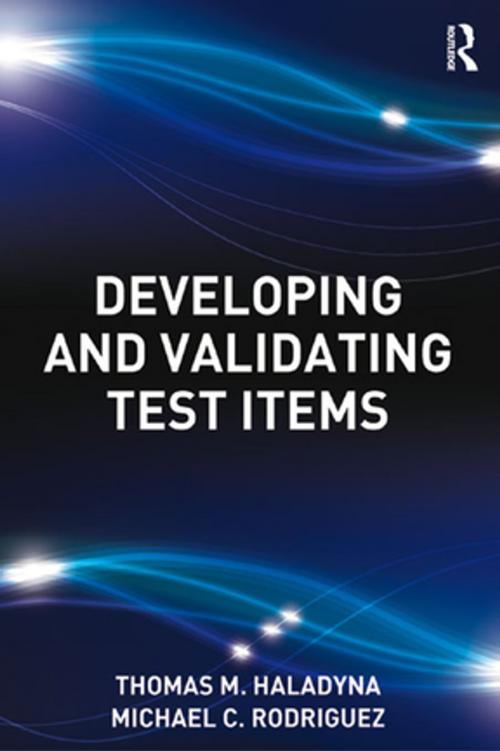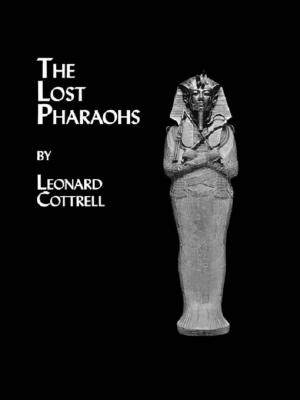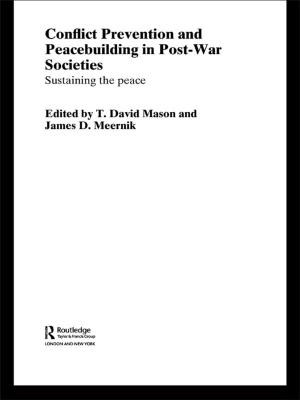Developing and Validating Test Items
Nonfiction, Reference & Language, Education & Teaching, Educational Theory, Testing & Measurement, Higher Education| Author: | Thomas M. Haladyna, Michael C. Rodriguez | ISBN: | 9781136961977 |
| Publisher: | Taylor and Francis | Publication: | July 18, 2013 |
| Imprint: | Routledge | Language: | English |
| Author: | Thomas M. Haladyna, Michael C. Rodriguez |
| ISBN: | 9781136961977 |
| Publisher: | Taylor and Francis |
| Publication: | July 18, 2013 |
| Imprint: | Routledge |
| Language: | English |
Since test items are the building blocks of any test, learning how to develop and validate test items has always been critical to the teaching-learning process. As they grow in importance and use, testing programs increasingly supplement the use of selected-response (multiple-choice) items with constructed-response formats. This trend is expected to continue. As a result, a new item writing book is needed, one that provides comprehensive coverage of both types of items and of the validity theory underlying them.
This book is an outgrowth of the author’s previous book, Developing and Validating Multiple-Choice Test Items, 3e (Haladyna, 2004). That book achieved distinction as the leading source of guidance on creating and validating selected-response test items. Like its predecessor, the content of this new book is based on both an extensive review of the literature and on its author’s long experience in the testing field. It is very timely in this era of burgeoning testing programs, especially when these items are delivered in a computer-based environment. Key features include …
Comprehensive and Flexible – No other book so thoroughly covers the field of test item development and its various applications.
Focus on Validity – Validity, the most important consideration in testing, is stressed throughout and is based on the Standards for Educational and Psychological Testing, currently under revision by AERA, APA, and NCME
Illustrative Examples – The book presents various selected and constructed response formats and uses many examples to illustrate correct and incorrect ways of writing items. Strategies for training item writers and developing large numbers of items using algorithms and other item-generating methods are also presented.
Based on Theory and Research – A comprehensive review and synthesis of existing research runs throughout the book and complements the expertise of its authors.
Since test items are the building blocks of any test, learning how to develop and validate test items has always been critical to the teaching-learning process. As they grow in importance and use, testing programs increasingly supplement the use of selected-response (multiple-choice) items with constructed-response formats. This trend is expected to continue. As a result, a new item writing book is needed, one that provides comprehensive coverage of both types of items and of the validity theory underlying them.
This book is an outgrowth of the author’s previous book, Developing and Validating Multiple-Choice Test Items, 3e (Haladyna, 2004). That book achieved distinction as the leading source of guidance on creating and validating selected-response test items. Like its predecessor, the content of this new book is based on both an extensive review of the literature and on its author’s long experience in the testing field. It is very timely in this era of burgeoning testing programs, especially when these items are delivered in a computer-based environment. Key features include …
Comprehensive and Flexible – No other book so thoroughly covers the field of test item development and its various applications.
Focus on Validity – Validity, the most important consideration in testing, is stressed throughout and is based on the Standards for Educational and Psychological Testing, currently under revision by AERA, APA, and NCME
Illustrative Examples – The book presents various selected and constructed response formats and uses many examples to illustrate correct and incorrect ways of writing items. Strategies for training item writers and developing large numbers of items using algorithms and other item-generating methods are also presented.
Based on Theory and Research – A comprehensive review and synthesis of existing research runs throughout the book and complements the expertise of its authors.















